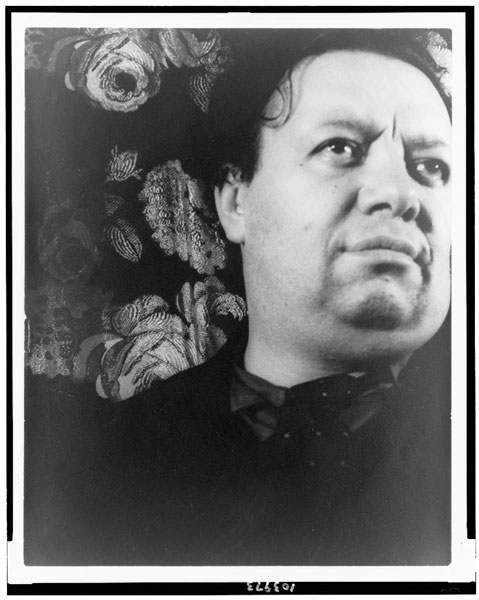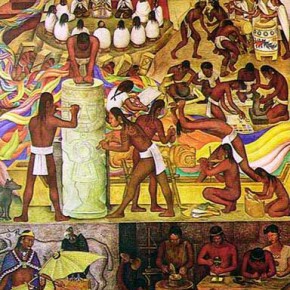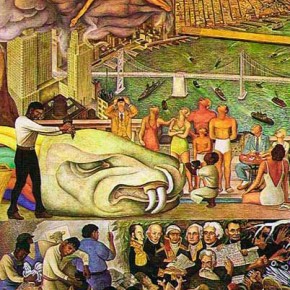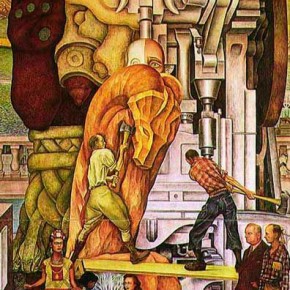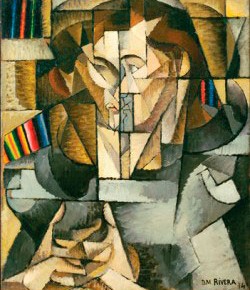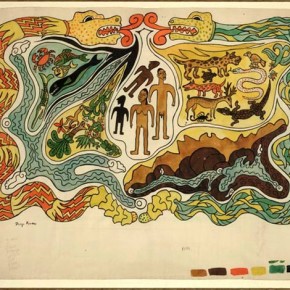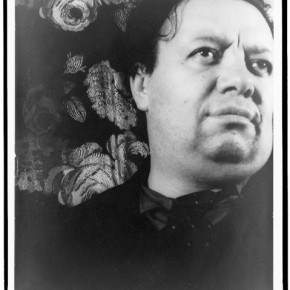It is with delicious irony that Diego Rivera was born in Guanajuato. In the indigenous Tarascon dialect, the name Guanajuato means: place of frogs. Often endearingly and sometimes not, Rivera, with rounded chin and eyes bulging with imagination acquired the nickname ‘Frog’.
Rivera’s claims to history include his tumultuous two marriages with Frida Kahlo and his thousands of meters of fresco paintings. He along with Jose Clemete Orozco, David Alfaro Siqueiros and Rufino Tamayo, led the renaissance movement in Mexican art murals in the early twenties.
His other legacy, his loyalty to his social and political beliefs was expressed through his art all his life, even if he could not be steadfast in his long-term personal relationships.
Born a twin, (his brother died before the age of two), he was an artistic child prodigy. (Coincidentally, Rivera’s only son died before the age of two as well.) He was keenly interested in all things mechanical and by his own account at age six declared himself an atheist in front of his whole church. At age nine he claims he was seduced by his eighteen year-old teacher. By sixteen, he was expelled from the San Carlos School of Fine Arts but his beliefs and destiny had already taken shape.
Born into wealth, he grew discontented with society after witnessing a massacre ordered by Porfirio Diaz against mill workers protesting for better conditions. He quickly channeled his young anarchic ideas into social democracy, until 1923 when he joined the Communist Party. Rivera was expelled from the party in 1929, but he remained true to the socialist-communist cause and the party re-instated him two years before his death.
In his early twenties, while studying in Europe he achieved international fame with a one-man exhibition in Paris. Influenced by Cezanne’s impressionism, Rivera experimented with cubism, hobnobbing with artists like Picasso, Mondrian, Seurat, Gris and Modigliani. He, however, always felt intimidated by the European sense of identity born of centuries of art history. He felt somehow out of place. Still, in Italy he learned fresco techniques and was inspired with the idea of depicting working-class society, who he felt should have access to art in public places like post offices, schools, train stations and libraries. Frescoes were the answer.
When he returned from Europe, his roots rejuvenated him. After that, any time he traveled, returning to Mexico was an injection of energy and ideas. He always felt that if an artist was rooted to his own beginnings, the whole world could better accept and understand the work. He was greatly influenced by Mexican Pre-Conquest art with its affinity to the soil, landscapes, animals, and its Indian deities. One of his early teachers and mentor, a folk artist, José Guadalupe Posada taught him not only technique, but also that “…the soul of every masterpiece is powerful emotion”. Posada instilled in Rivera a reverence for Mexico, its history, trials, and enormous physical beauty. This ultimately inspired Rivera to become a timeless painter.
In Mexico, he received commissions for massive frescoes in public buildings, his dream. His idea was to use the architecture in the murals. He did not want the works to be mere wall decorations. He studied how the light fell on the walls, how he could include archways, pillars and staircases. On his second large commission in the Ministry of Education building, he painted heavy darker colors at the base of the mural corresponding to the base of the architecture. As the architectural lines lightened, so did his colors. In one of his personal favorite works at the National Palace in Mexico City, he painted the upward rise of the revolution to correspond with the upward ascent of the staircase.
Theme was equally important to his works. For the remainder of his life, he exalted the working classes but included all walks of life in his epic paintings. Often he told stories of Indian culture up to the time of conquest, independence and the Mexican Revolution, depression times and the beginnings of industrialization.
One of his more interesting commissions was for Edsel Ford at the Detroit Institute of Arts. He transformed the toiling agrarian classes into the toiling industrialists. The theme of polluting industry and alleged blasphemies offended the upper classes and the clergy who viewed the work upon its opening. Rivera argued that it was precisely because of steel plant production that people became rich. Ultimately the Institute extolled the mechanical correctness in the images. The mural stood. The frescoes are a fine example of Rivera’s art portraying the cool, clean lines of mechanization.
Almost always, when Rivera painted murals there was controversy. Being atheistic, he offended people, sneaking in lines like “God does not exist” or controversial poems, notes or bold depictions of racism or exploitation. Rivera seldom backed down.
Perhaps the most famous controversial commission was for the RCA building at Rockefeller center in New York. Although praised for the artwork, there was strong objection to an image of Vladimir Lenin holding the hands of a black American and a white Russian. The Cold War was not yet upon the states but blatantly exalting a Communist figure was unacceptable. Rivera refused to erase Lenin’s face. Ultimately the entire mural was destroyed, but he was paid for his work. Later he replicated the mural at the Palace of Fine Arts in Mexico this time with a figure of Rockefeller included.
In spite of his unwavering fidelity to socialism, Rivera was suspected of complicity in an attempt to assassinate Leon Trotsky who exiled in Mexico. Not only did Rivera share beliefs with Trotsky, he also shared his home (and his wife Frida, maybe not willingly).
There were so many controversies with so many murals particularly with social themes that Rivera eventually painted on movable panels in case they were threatened. He remained true to his belief system in this respect: paintings of the people and for the people.
-originally published, May 2011
- Unidad Panamericana Panel 1 (Pan American Unity Panel 1) By Diego Rivera. City College of San Francisco, California. 1940.
- Unidad Panamericana Panel 2 (Pan American Unity Panel 2) By Diego Rivera. City College of San Francisco, California. 1940.
- Unidad Panamericana Panel 3 (Pan American Unity Panel 3) By Diego Rivera. City College of San Francisco, California. 1940.
- Cubist portrait called Retrato Jacques Lipschitz, by Diego Rivera, 1916.
- The Creation. Illustration to Popol Vuh, by Diego Rivera, 1931.
- Diego Rivera (1886-1957)

